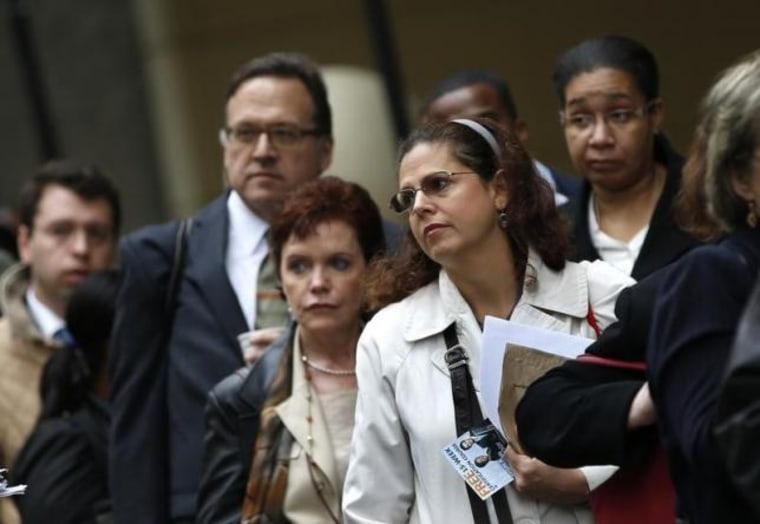Economists say June's booming job growth likely reaffirms the Federal Reserve's plans for the rest of the year, including an interest-rate hike, even as lagging wages continue to cast a cloud on economic growth.
The 222,000 jobs the Bureau of Labor Statistics said the economy added in June far outpaced economists' estimates of 179,000, and upward revisions of the April and May figures added a total of 47,000 more jobs.
"Our recovery looks very healthy from a perspective of how long it's lasted," Gary Burtless, a labor economist at the Brookings Institution, told NBC News.
Other measures of job creation and labor market strength show more of a mixed bag. Thursday's private-sector jobs report from ADP and Moody's Analytics found that the U.S. added a fewer-than-expected 158,000 in June, and that goods-producing jobs were essentially flat.
Related: Small Business Hiring Slowed Dramatically in June
"We've seen all the jobs coming from mostly service-producing sectors," said Ahu Yildirmaz, vice president and head of the ADP Research Institute. "It's primarily professional and business services and healthcare," she said.
But economists say a mature recovery can weather such fluctuations. "It just goes to show you that there are few signs of any slowing in the labor market, and despite headwinds, the economy keeps creating jobs," said Andrew Chamberlain, chief economist at Glassdoor.com.
Both the topline unemployment rate of 4.4 percent and the broader U-6 measure of 8.6 percent in June ticked up from May (by 0.1 percent and 0.2 percentage points, respectively), but the labor force participation rate also rose by 0.1 to 62.8 percent. (The U-6 measure includes underemployed workers and discouraged job seekers.)
Economists say this indicates that more Americans without jobs are getting off the sidelines and looking for work, a sign that the labor market still has room to strengthen and raises the prospect of greater wage growth, which has remained stuck — as it was in June — around the 2.5 percent mark, well below the 3.5 to 4 percent economists consider healthy.
"There's still a fair amount of slack in the labor market," said IHS Markit chief economist Nariman Behravesh. "If we keep this up, in a year's time this slack will be largely gone. That's the point at which we think wage growth will start to accelerate."
The Inflation Question
Wage growth also could strengthen the Federal Reserve's position that recent below-average inflation levels will not remain that way for the long term. Conversely, a continual lag in wage growth through the second half of the year could hold down inflation, Chamberlain said.
"Wages make up a large portion of the total cost bill for many companies, and that affects prices," he said. "If we don't see significant wage growth, it's unlikely we'll start to see a ramp-up of inflation anytime soon."
But for now, many economists said June's jobs report does little to alter the central bank's anticipated activity for the rest of the year: A move to begin winding down its balance sheet in September, followed by a rate increase in December.
"All this is probably doing is just confirming for the Fed that we need to continue the process of normalization," said Scott Wren, senior global equity strategist for the Wells Fargo Investment Institute.
About that 3 Percent GDP Goal...
Economists do caution that predictions by President Donald Trump's administration of GDP growth of 3 to 4 percent don't reflect current economic reality.
"What's ultimately going to drive GDP is consumption, investment, government spending and exports," Chamberlain told NBC News. "Consumption makes about two-thirds of GDP — if wages are growing really slowly, you're not going to see a big ramp-up in consumption."
June's jobs report reflects this, according to Bankrate.com senior economic analyst Mark Hamrick. "This isn't a 3 percent growth economy and this isn't a 3 percent growth jobs report," he said.
"Going forward, we think payroll jobs growing in the 150,000 to 180,000 range is what we're going to get. This is consistent with an economy that's growing at 2, 2.5 percent," Behravesh said.
To get higher than the middle of that range, economists say, will take legislative action on tax cuts and infrastructure spending that, so far, has been absent.
Where's the Stimulus Package?
"Job one for Congress and this new administration is to figure out how to extend this current expansion," Wren said. "It seems to us we're going to need some fiscal push to extend this expansion [and] get some sort of a combination of tax cuts, infrastructure spending, less regulation — they're going to need a combination of all these things to move the needle," he said.
"We were assuming some kind of stimulus would be enacted by now or at least would be discussed in detail by now," Behravesh said. "Next year… if that does not happen, we're back around 2.3 percent."
And the longer Congress and the White House remain gridlocked over health care and mired in distractions like the Russia investigation, the less likely hitting those growth target becomes, Hamrick said. "To the extent we don't know what any of that legislation would actually look like, it's highly unlikely you can expect a 3 percent growth path."
